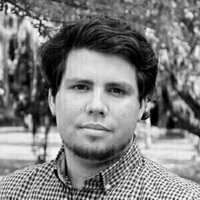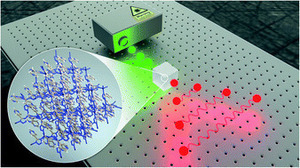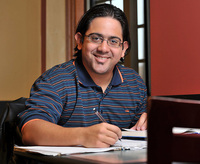
He didn’t plan it, but years later, Assistant Professor Yamil Colón would once again find himself under the glow of the Golden Dome.
Back in 2005, he was a freshman just arrived from Bayamón, Puerto Rico, with little experience outside the island — his first impressions of Notre Dame the football games on T.V. he occasionally watched as a kid.
In due time, he earned his degree in chemical engineering, cum laude, and headed off to Spain on a Fulbright to tackle the next challenge on the horizon.
Fast forward to 2018, and Colón would return to Notre Dame. Fresh off a prestigious post at Argonne National Laboratory and the University of Chicago, he began a stint as a Visiting Professor in the Department of Chemical and Biomolecular Engineering. The following year, the position became permanent: Now he was Yamil Colón, Assistant Professor.
“The journey has been quite surreal,” says Colón, a faculty fellow with the Institute for Latino Studies.
Since returning, Colón has focused on building up his own lab, the Colón Group, and publishing at a rapid clip.
Colón and his team use computerized molecular modeling to study the behaviors of fluids in porous materials. When we spoke in November, Colón had just given a presentation at this year’s annual meeting of the American Institute of Chemical Engineers, the most prestigious conference in the field.
During his talk, entitled “Engineering Entangled Photon Pairs with Metal-Organic Frameworks”, Colón explained how to use MOFs, as these are known, to accelerate scalable photonics quantum technologies, specifically through the computer-generated discovery of molecular materials.

Two of his graduate student researchers, Krishnendu Mukherjee and Christian Villa Santos, also shared research findings related to adsorption simulations they had done in Colon’s lab. Adsorption (not to be confused with absorption) is the adhesion to a surface by atoms, ions, or molecules from a liquid, dissolved solid, or gas.
In total, Colón’s lab includes five graduate students, six undergraduates, and one postdoctoral researcher. Colón is able to pay his undergraduate assistant Jack Gonzalez using a faculty research grant of $3,000 from the Institute for Latino Studies; it’s one of the many perks of being a faculty fellow.

For graduate researcher Fernando Carmona Esteva, working with Colón has broadened his perspective as he seeks to tackle sustainability issues by researching ionic liquids. An ionic liquid is basically a form of salt that has been melted down without decomposing or vaporizing, held together by the attractive force of oppositely charged atoms.
Carmona Esteva uses computational chemical engineering to study these substances, and he is particularly interested in developing more efficient ways of mining rare earth elements. Rare earth elements are key to electronics manufacturing and other industries, but getting them out of the earth leads to the creation of wastewater and potentially a host of environmental issues.
He joined Colón’s lab in late 2020, and says he’s learned a lot under his tutelage. “I consider him a mentor, and I really enjoy that,” he says.
Like Colón, Carmona Esteva is from Puerto Rico. He was there for Hurricane María in 2017, and he acutely remembers not having electricity for months. Because of this, he has future aspirations for helping power plants and water processing operations be more resilient during natural disasters.
“Being in the lab has affected what I would like to do with my career as a researcher in this sense,” he says. “When I eventually have my academic career, I want to look at how these systems can be sustainable.”

The most recent publication put out by the Colón group, “Machine learning and descriptor selection for the computational discovery of metal-organic frameworks,” speaks to the growing importance of machine learning in the field. Featured in Molecular Simulation, with Mukherjee as lead author, the paper offers a sharp analysis on the state of this technology and its future.
“There are so many potential materials with so many potential properties, that we don’t want to have experiments or computer simulations on every material,” Colón explains. “Machine learning is a very mature field, and with the data explosion of the past decade, now these machine learning algorithms can truly be used in a powerful way to help us figure out where to focus our energies.”
Collaboration is key in this field, Colón says. More often than not, he’s involved in projects involving researchers from across the country and internationally. Working with scientists at other institutions provides “experimental validation” and the confidence that they are on the right track.
This ethos starts in his own lab, with a person-centered philosophy oriented towards helping team members grow as researchers and students while working for a common cause.
“That’s the underlying mantra for what we do,” he said. “The research becomes a side product, but an important one.”

Outside of his involvement with the Institute for Latino Studies, he participates in a mentorship program known as Building Bridges, which matches first-year students from diverse backgrounds with faculty in their area. The program, organized by Multicultural Student Programs and Services, was critical in helping him adjust at Notre Dame as a student. In addition, he’s involved in the Mary Galvin Scholars Program.
Besides funding for one of his undergraduate assistants, the Institute for Latino Studies has also helped him recruit graduate students. He’s happy to see how the ILS has become an important part of the Notre Dame community since he was a student just over a decade ago.
Certainly, he feels he made the most of his time as an undergraduate. Dance, for one, was his primary extracurricular passion — he did choreographed reggaetton, bachata, and salsa performances as part of the annual student showcase Latin Expressions. The intercollegiate ballroom dancing team provided another forum to develop his skills in this arena.
“It’s wonderful being back,” he says. “It gives me agency in trying to diversify our graduate student population and give our undergraduates a good experience…It’s extremely satisfying, and the fact that I get to do it at my alma mater makes it sweeter.”
Originally published by Oliver Ortega at latinostudies.nd.edu on December 02, 2021.